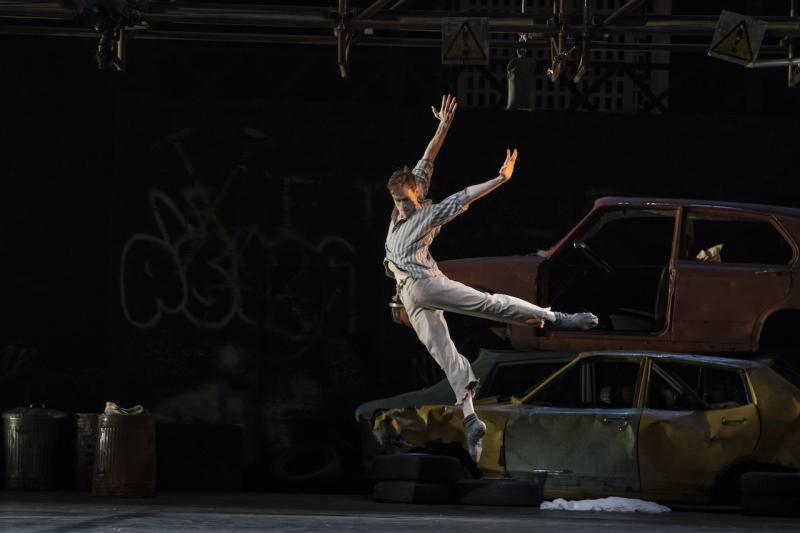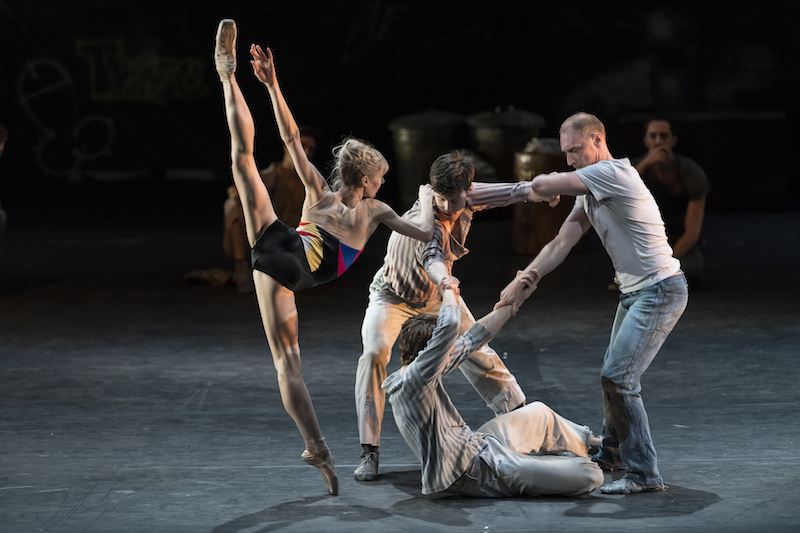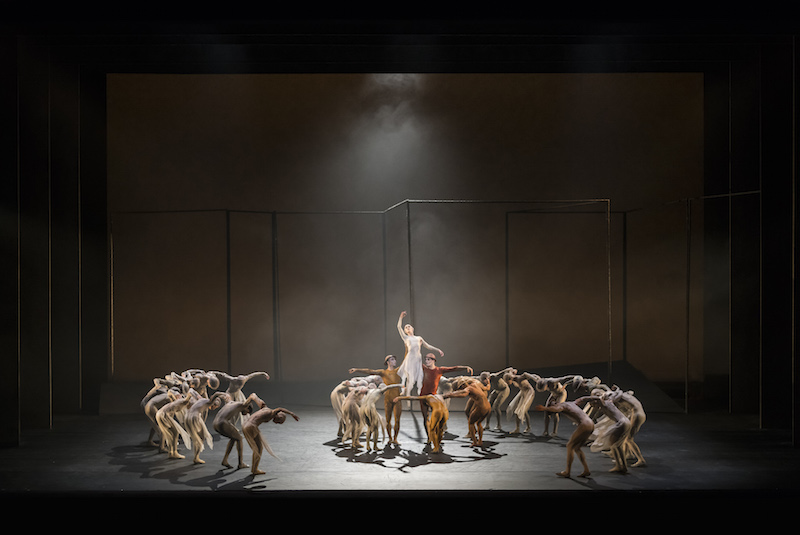Kenneth MacMillan: A National Celebration, Programmes 2 & 3, Royal Opera House review - abhorrent to sublime | reviews, news & interviews
Kenneth MacMillan: A National Celebration, Programmes 2 & 3, Royal Opera House review - abhorrent to sublime
Kenneth MacMillan: A National Celebration, Programmes 2 & 3, Royal Opera House review - abhorrent to sublime
One choreographer, many faces: two works of genius and a torrid muddle

The choreographer Kenneth MacMillan was a man of many modes and moods, and it’s tempting to wonder how many more he might have revealed had he not been felled by a heart attack at the age of 62.
Giving repeat exposure to a work that so starkly divided audiences first time round was a calculated risk. There was always the chance that a quarter-century’s distance might bring a new perpective on it, make us see what MacMillan was getting at. But I don’t think we do. The Judas Tree is wilfully obscure, despite a naturalistic look that tricks us into thinking otherwise. The stage shows a building site at Canary Wharf – totem of the shiny, thrusting 1990s, but as yet a wasteland of graffiti and dumped cars. Teams of workmen on the night shift are delivering girders. One of them, unwrapped, turns out to be a scantily clad woman. The music (by Brian Elias), sinister with steel pans, tells us this won’t play well for her. The characters are unnamed, but we are encouraged to think biblically: the Foreman is Judas Iscariot, who marks out Jesus with a kiss. The Woman – wanton, whoreish – can only be Mary Magdalene, but wait, no, she’s sometimes the other, virginal Mary, and she is also apparently the Foreman’s girlfriend, goading him by flirting with his Friend. Gang rape and murder follow swiftly, and if this were solely an examination of toxic masculinity (pertinent right now), you would say the ballet succeeds depressingly well. But the woman’s place in it leaves us feeling queasy. MacMillan could be acute in exploring hidden motivations, the roots of human misery, but here there are just too many layers to unpack.
The characters are unnamed, but we are encouraged to think biblically: the Foreman is Judas Iscariot, who marks out Jesus with a kiss. The Woman – wanton, whoreish – can only be Mary Magdalene, but wait, no, she’s sometimes the other, virginal Mary, and she is also apparently the Foreman’s girlfriend, goading him by flirting with his Friend. Gang rape and murder follow swiftly, and if this were solely an examination of toxic masculinity (pertinent right now), you would say the ballet succeeds depressingly well. But the woman’s place in it leaves us feeling queasy. MacMillan could be acute in exploring hidden motivations, the roots of human misery, but here there are just too many layers to unpack.
The big idea of this MacMillan season is to open up his work to other UK companies
It’s to their huge credit that both casts fielded by the Royal Ballet inhabit their archetypes with utter conviction, Thiago Soares’ Foreman throwing off huge priapic leaps, Bennet Gartside’s a coiled spring of anger. His bashing the floor repeatedly with his fists is even nastier than the sexual violence. Both Women (first Lauren Cuthbertson, then Melissa Hamilton, pictured above, with Gartside) spatchcock themselves in the service of the choreography with equal improbability. At times you can hardly bring yourself to watch.
The big idea of this MacMillan season being to open up his work to other companies, the companion works on each of these programmes are picked up by English National Ballet and Northern Ballet, both of which have been touring their contributions elsewhere. The sharing has created a rare atmosphere of collaboration and discovery and shown the visiting companies as more than equal to the challenge.
ENB delivered an exquisitely elegiac Song of the Earth, another multi-layered creation but one that grows and glows with successive viewings. In this case the layers are transparent. There is the Chinese element from the ancient poems that Mahler set for singers and orchestra, there’s Mahler’s personal motivation for writing the music (he had just been diagnosed with a fatal heart condition), then there’s MacMillan’s choreographic response to both. Death stalks this hour-long ballet in the character of the Messenger (visiting guest principal Jeffrey Cirio, insinuating and quick as a knife), yet the great achievement of both Mahler and MacMillan is in showing that acceptance of his presence can co-exist with joy.
Restraint is the key to this strange and wonderful work: emotional restraint alongside sculptural vividness. ENB’s dancers have understood this perfectly. The work being new to them, the ensemble is still a little ragged at the edges – you see, they’ll be tidy by the time they revive it at the Coliseum in January – but they honour the details beautifully: the flexed wrists of the young girls picking lotus buds, the line of headstands as the boys mimic their reflections in a pond. This was so deftly done, it raised a laugh.
Erina Takahashi, as the soon-to-be-bereaved woman, is small in scale, a netsuke of a ballerina, but you learn to read her subtleties as the ballet progresses. Her fluttering bourrées that ride the fading final waves of music, and the singer’s long diminuendo on the repeated word “Ewig…” (“forever…”) leave you unwilling to breathe and break the spell. Northern Ballet had never tackled MacMillan before, and my hopes were (I’m ashamed to say) not high for their staging of Gloria, an expressionist response to Vera Brittain’s Testament of Youth, about the blighted hopes of youth in the First World War. How wrong I was. Again, they showed an in-depth grasp of the choreographer’s mode of thinking – it goes far beyond the steps. They didn’t emote. They let the shapes, and the astonishingly inventive steps, take the emotional load: tommies’ dreams of mothers and sweethearts pervading the (imagined) mud and shrapnel; the injured begging for the embrace of death as Poulenc’s chorus sings lustily of God’s mercy. Where was that god in 1917 is one of the ballet’s implicit questions.
Northern Ballet had never tackled MacMillan before, and my hopes were (I’m ashamed to say) not high for their staging of Gloria, an expressionist response to Vera Brittain’s Testament of Youth, about the blighted hopes of youth in the First World War. How wrong I was. Again, they showed an in-depth grasp of the choreographer’s mode of thinking – it goes far beyond the steps. They didn’t emote. They let the shapes, and the astonishingly inventive steps, take the emotional load: tommies’ dreams of mothers and sweethearts pervading the (imagined) mud and shrapnel; the injured begging for the embrace of death as Poulenc’s chorus sings lustily of God’s mercy. Where was that god in 1917 is one of the ballet’s implicit questions.
Antoinette Brooks-Daw is impeccable as the sliver of silver – hardly a woman, more a wreath of smoke, or the memory of a perfume – who haunts soldier Javier Torres, wrapping her body around him. Riku Ito makes a fine job of the solo tommy role on which Carlos Acosta left such an imprint at the Royal Ballet. When Ito finally drops out of sight over the stage horizon – MacMillan’s solution to “going over the top” – the sense of loss is devastating.
So, to Northern and to ENB, bravo. And may the spirit of sharing not end here. The genius of MacMillan – his work is uneven, yes, but at best, unparalleled – can’t be the preserve of the Royal Opera House. It needs to be known around Britain.
rating
Explore topics
Share this article
Add comment
The future of Arts Journalism
You can stop theartsdesk.com closing!
We urgently need financing to survive. Our fundraising drive has thus far raised £49,000 but we need to reach £100,000 or we will be forced to close. Please contribute here: https://gofund.me/c3f6033d
And if you can forward this information to anyone who might assist, we’d be grateful.

Subscribe to theartsdesk.com
Thank you for continuing to read our work on theartsdesk.com. For unlimited access to every article in its entirety, including our archive of more than 15,000 pieces, we're asking for £5 per month or £40 per year. We feel it's a very good deal, and hope you do too.
To take a subscription now simply click here.
And if you're looking for that extra gift for a friend or family member, why not treat them to a theartsdesk.com gift subscription?
more Dance
 'We are bowled over!' Thank you for your messages of love and support
Much-appreciated words of commendation from readers and the cultural community
'We are bowled over!' Thank you for your messages of love and support
Much-appreciated words of commendation from readers and the cultural community
 How to be a Dancer in 72,000 Easy Lessons, Teaċ Daṁsa review - a riveting account of a life in dance
Michael Keegan-Dolan's unique hybrid of physical theatre and comic monologue
How to be a Dancer in 72,000 Easy Lessons, Teaċ Daṁsa review - a riveting account of a life in dance
Michael Keegan-Dolan's unique hybrid of physical theatre and comic monologue
 A Single Man, Linbury Theatre review - an anatomy of melancholy, with breaks in the clouds
Ed Watson and Jonathan Goddard are extraordinary in Jonathan Watkins' dance theatre adaptation of Isherwood's novel
A Single Man, Linbury Theatre review - an anatomy of melancholy, with breaks in the clouds
Ed Watson and Jonathan Goddard are extraordinary in Jonathan Watkins' dance theatre adaptation of Isherwood's novel
 Peaky Blinders: The Redemption of Thomas Shelby, Rambert, Sadler's Wells review - exciting dancing, if you can see it
Six TV series reduced to 100 minutes' dance time doesn't quite compute
Peaky Blinders: The Redemption of Thomas Shelby, Rambert, Sadler's Wells review - exciting dancing, if you can see it
Six TV series reduced to 100 minutes' dance time doesn't quite compute
 Giselle, National Ballet of Japan review - return of a classic, refreshed and impeccably danced
First visit by Miyako Yoshida's company leaves you wanting more
Giselle, National Ballet of Japan review - return of a classic, refreshed and impeccably danced
First visit by Miyako Yoshida's company leaves you wanting more
 Quadrophenia, Sadler's Wells review - missed opportunity to give new stage life to a Who classic
The brilliant cast need a tighter score and a stronger narrative
Quadrophenia, Sadler's Wells review - missed opportunity to give new stage life to a Who classic
The brilliant cast need a tighter score and a stronger narrative
 The Midnight Bell, Sadler's Wells review - a first reprise for one of Matthew Bourne's most compelling shows to date
The after-hours lives of the sad and lonely are drawn with compassion, originality and skill
The Midnight Bell, Sadler's Wells review - a first reprise for one of Matthew Bourne's most compelling shows to date
The after-hours lives of the sad and lonely are drawn with compassion, originality and skill
 Ballet to Broadway: Wheeldon Works, Royal Ballet review - the impressive range and reach of Christopher Wheeldon's craft
The title says it: as dancemaker, as creative magnet, the man clearly works his socks off
Ballet to Broadway: Wheeldon Works, Royal Ballet review - the impressive range and reach of Christopher Wheeldon's craft
The title says it: as dancemaker, as creative magnet, the man clearly works his socks off
 The Forsythe Programme, English National Ballet review - brains, beauty and bravura
Once again the veteran choreographer and maverick William Forsythe raises ENB's game
The Forsythe Programme, English National Ballet review - brains, beauty and bravura
Once again the veteran choreographer and maverick William Forsythe raises ENB's game
 Sad Book, Hackney Empire review - What we feel, what we show, and the many ways we deal with sadness
A book about navigating grief feeds into unusual and compelling dance theatre
Sad Book, Hackney Empire review - What we feel, what we show, and the many ways we deal with sadness
A book about navigating grief feeds into unusual and compelling dance theatre
 Balanchine: Three Signature Works, Royal Ballet review - exuberant, joyful, exhilarating
A triumphant triple bill
Balanchine: Three Signature Works, Royal Ballet review - exuberant, joyful, exhilarating
A triumphant triple bill
 Romeo and Juliet, Royal Ballet review - Shakespeare without the words, with music to die for
Kenneth MacMillan's first and best-loved masterpiece turns 60
Romeo and Juliet, Royal Ballet review - Shakespeare without the words, with music to die for
Kenneth MacMillan's first and best-loved masterpiece turns 60

Comments
It has been a pleasure to see